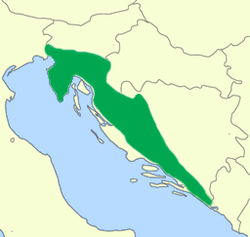Olm
| Olm | |
|---|---|
 |
|
| Olms in Postojna Cave, Slovenia | |
| Scientific classification | |
| Kingdom: | Animalia |
| Phylum: | Chordata |
| Class: | Amphibia |
| Subclass: | Lissamphibia |
| Order: | Caudata |
| Family: | Proteidae |
| Genus: |
Proteus Laurenti, 1768 |
| Species: | P. anguinus |
| Binomial name | |
|
Proteus anguinus Laurenti, 1768 |
|
| Subspecies | |
|
Proteus anguinus anguinus |
|
 |
|
| Range (north of the Adriatic Sea) | |
Proteus anguinus anguinus
Laurenti, 1768
Proteus anguinus parkelj
Sket & Arntzen, 1994
The olm or proteus (Proteus anguinus) is an aquatic salamander in the family Proteidae, the only exclusively cave-dwelling chordate species found in Europe. In contrast to most amphibians, it is entirely aquatic; it eats, sleeps, and breeds underwater. Living in caves found in the Dinaric Alps, it is endemic to the waters that flow underground through the extensive limestone of the karst of Central and Southeastern Europe, specifically southern Slovenia, the basin of the Soča River (Italian: Isonzo) near Trieste, Italy, southwestern Croatia, and Bosnia and Herzegovina.
It is also called the "human fish" by locals because of its skin color, similar to that of Caucasian people (translated literally from Slovene: človeška ribica, Bosnian: čovječja ribica and Croatian: čovječja ribica), as well as "cave salamander" or "white salamander". In Slovenia, it is also known by the name močeril, which translates as "the one that burrows into wetness". It was first mentioned in 1689 by the local naturalist Valvasor in his Glory of the Duchy of Carniola, who reported that, after heavy rains, the olms were washed up from the underground waters and were believed by local people to be a cave dragon's offspring.
...
Wikipedia

